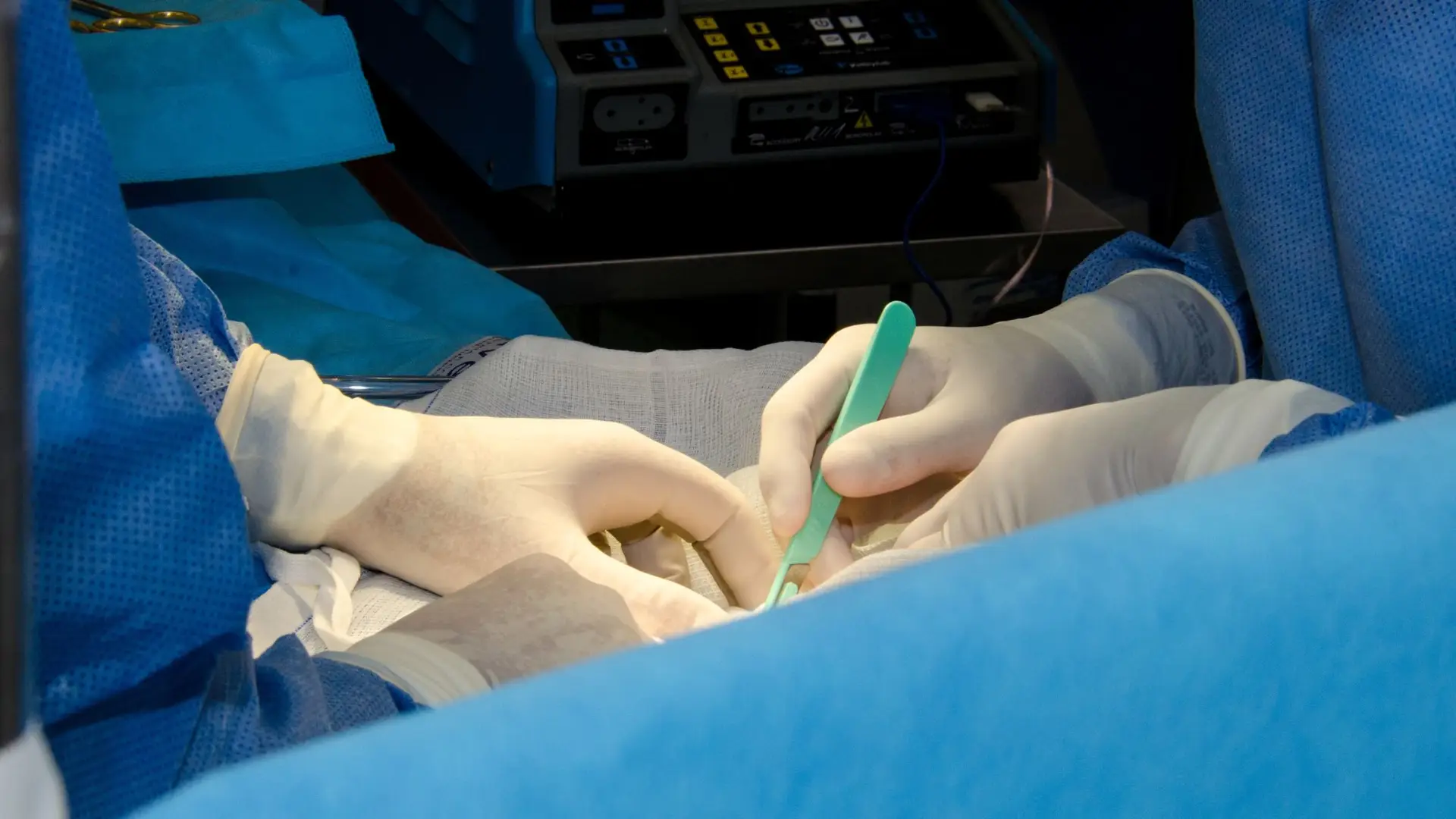
Surgery and Chronic Pain
Surgery can be an option for chronic pain when other treatments haven’t provided relief. However, it’s crucial to thoroughly explore non-surgical options before considering surgical interventions. Types of surgeries for chronic pain include:
Neurostimulation
Neurostimulation, a revolutionary treatment modality, has transformed the landscape of chronic pain management. This advanced technique involves the use of implanted devices that deliver electrical impulses to specific nerves or the spinal cord, disrupting pain signals and providing relief for individuals enduring persistent, debilitating pain.
Primarily utilized when conventional therapies fail to yield adequate relief, neurostimulation offers a beacon of hope for various chronic pain conditions. Its application spans a wide array of ailments, including neuropathic pain, failed back surgery syndrome, complex regional pain syndrome, and certain intractable headaches.
The process begins with a trial period, wherein a temporary neurostimulator is placed near the targeted nerves or spinal cord. This trial helps determine the device’s efficacy in alleviating pain before committing to permanent implantation. Should the trial prove successful and significantly reduce the pain, a permanent neurostimulator is surgically implanted, customized to suit the patient’s specific needs.
The implanted device operates by emitting electrical impulses that interfere with pain signals, modulating the perception of pain and potentially improving overall function and quality of life. Patients often describe the sensation as tingling or buzzing, which replaces the sensation of pain, offering considerable relief.
Advantages of neurostimulation include its reversible nature, allowing adjustments or removal if necessary. Moreover, it presents a non-pharmacological approach, minimizing the need for opioids or other systemic medications that might cause adverse side effects or dependency.
However, while neurostimulation showcases promising outcomes for many, it might not be suitable for everyone. Factors such as medical history, the type of pain, and individual response to the trial phase must be carefully assessed.
In essence, neurostimulation stands as a beacon of hope for those grappling with chronic, unremitting pain. Its ability to offer relief where traditional treatments falter signifies a paradigm shift in pain management, heralding a new era of customized, targeted therapies tailored to individual needs.
Peripheral Nerve Surgery
Peripheral nerve surgery represents a specialized branch within the realm of surgical interventions for chronic pain. Targeting specific peripheral nerves responsible for transmitting pain signals, this surgical approach aims to alleviate debilitating pain that persists despite conservative treatments.
Often, chronic pain arises from conditions like nerve entrapment, compression, or injury, such as carpal tunnel syndrome, sciatica, or nerve damage due to trauma or surgery. When these conditions severely impact one’s quality of life and traditional therapies fail to provide relief, peripheral nerve surgery emerges as a viable option.
The surgical procedure involves meticulous identification and decompression of the affected nerve, relieving the pressure or releasing entrapment, thereby interrupting the transmission of pain signals. In cases of nerve damage, surgical repair or reconstruction may be necessary to restore proper nerve function and alleviate pain.
Successful outcomes depend on precise diagnosis, skillful surgical techniques, and comprehensive post-operative care. Patients undergo thorough evaluations, including imaging studies and nerve conduction tests, to identify the precise location and nature of nerve damage or compression before surgery.
Post-surgery, rehabilitation often includes physical therapy to optimize recovery and restore normal function. While the success rates of peripheral nerve surgery vary based on individual circumstances, many patients experience significant pain relief and functional improvement following the procedure.
However, like any surgical intervention, peripheral nerve surgery carries potential risks and complications, including infection, scarring, or recurrence of symptoms. Careful consideration, consultation with specialists, and weighing the risks against potential benefits are crucial steps in determining the suitability of this surgical option.
In essence, peripheral nerve surgery stands as a specialized yet effective intervention for chronic pain stemming from nerve-related issues. Its tailored approach addresses the root cause of pain, offering hope and improved quality of life for individuals suffering from persistent, debilitating pain conditions.

Spinal Cord Stimulation (SCS)
Spinal Cord Stimulation (SCS) has emerged as a pioneering technique in chronic pain management, revolutionizing the treatment landscape for individuals grappling with persistent and challenging pain conditions. This advanced therapy involves the implantation of a device that delivers mild electrical impulses to the spinal cord, disrupting pain signals before they reach the brain.
Typically considered for individuals who have not found relief from conventional treatments or are not suitable candidates for surgery, SCS offers hope for various chronic pain conditions. It’s particularly effective for neuropathic pain, failed back surgery syndrome, complex regional pain syndrome, and certain types of leg pain.
The procedure starts with a trial phase where a temporary stimulator is placed near the spinal cord to assess its efficacy in alleviating pain. During this trial period, patients can gauge how effectively the device mitigates their pain. If the trial is successful in significantly reducing pain and improving functionality, a permanent SCS device is implanted in a subsequent procedure.
The implanted device functions by emitting mild electrical impulses that interfere with pain signals traveling along the spinal cord. These impulses create a tingling sensation, known as paresthesia, which replaces the perception of pain. Moreover, newer advancements in SCS technology include devices that can adjust the stimulation without causing paresthesia, offering more personalized and precise pain relief.
One of the key advantages of SCS is its reversibility, allowing adjustments or removal if necessary. It also reduces the need for systemic medications, potentially minimizing side effects associated with long-term medication use.
Nevertheless, SCS might not be suitable for everyone, and its success depends on various factors including the type of pain and individual response. Complications such as device malfunction, infection, or displacement are also possible, underscoring the importance of thorough evaluation and expert guidance.
In summary, Spinal Cord Stimulation stands at the forefront of innovative pain management strategies. Its ability to modulate pain signals offers renewed hope for individuals enduring chronic, persistent pain, paving the way for improved quality of life and functional restoration.
Rhizotomy
Rhizotomy, a surgical procedure aimed at managing chronic pain, specifically targets nerve roots within the spinal cord to disrupt pain signals. This intervention, often considered when other treatments fail to provide relief, focuses on alleviating pain arising from conditions like spinal arthritis, nerve damage, or persistent back pain.
During a rhizotomy, a surgeon carefully identifies and selectively damages specific nerve roots responsible for transmitting pain signals. This procedure can be performed through various methods, including radiofrequency ablation or surgical cutting, aiming to interrupt the nerve’s ability to communicate pain to the brain.
The primary goal of rhizotomy is to alleviate chronic pain by blocking the transmission of pain signals along the affected nerve pathways. By selectively targeting these nerves, the procedure aims to provide sustained relief, improving the patient’s quality of life and functionality.
Rhizotomy is typically considered after a thorough evaluation, including imaging studies and nerve conduction tests, to precisely identify the source of pain and determine the most suitable candidates for the procedure. It’s crucial to weigh the potential benefits against the risks, as with any surgical intervention.
While rhizotomy can offer significant pain relief for many individuals, it’s essential to note that results may vary based on individual circumstances. Complications such as nerve damage, infection, or temporary numbness might occur post-procedure.
Patients usually undergo a period of rehabilitation and physical therapy following rhizotomy to optimize recovery and regain function. Close collaboration between the patient and healthcare professionals is vital to monitor progress and address any post-operative concerns.
In essence, rhizotomy stands as a targeted surgical approach addressing chronic pain conditions by selectively disrupting pain signals. Though it may not be suitable for everyone, its potential to provide substantial and long-lasting pain relief highlights its role as a valuable option in comprehensive pain management strategies.
Dorsal Root Entry Zone (DREZ) Lesioning
Dorsal Root Entry Zone (DREZ) Lesioning is a surgical procedure specifically designed to address severe and intractable neuropathic pain resulting from nerve injury or nerve-related conditions. This intricate and specialized intervention targets the dorsal root entry zone in the spinal cord, aiming to disrupt abnormal pain signals that persist despite conventional treatments.
Typically considered as a last resort when other therapies have failed to provide relief, DREZ lesioning involves precisely pinpointing and creating small lesions in the dorsal root entry zone, where sensory nerves enter the spinal cord. These lesions disrupt or alter the abnormal pain signals, effectively reducing the perception of pain.
The procedure demands meticulous precision and thorough pre-operative assessments, including neuroimaging studies and nerve conduction tests, to precisely locate the specific nerves causing the pain and to determine the feasibility of the surgery. Due to the complexity and potential risks involved, patient selection is critical, and careful consideration is given to ensure the potential benefits outweigh the risks.
Following DREZ lesioning, patients usually undergo a period of rehabilitation and physical therapy to optimize recovery and restore function. However, it’s important to note that the outcomes of this procedure can vary among individuals, and there are potential risks, including sensory deficits or other neurological complications.
While DREZ lesioning remains a highly specialized and targeted approach for severe neuropathic pain, it’s reserved for specific cases due to its complexity and potential risks. Collaborative decision-making between patients and healthcare providers, thorough evaluation, and careful consideration of alternative options are essential in determining the appropriateness of this procedure within the spectrum of pain management strategies.

Joint Replacement Surgery
Joint replacement surgery stands as a transformative intervention for individuals suffering from debilitating joint pain caused by conditions like severe arthritis or joint damage. This surgical procedure aims to alleviate pain, improve mobility, and enhance the overall quality of life by replacing damaged or diseased joint surfaces with artificial implants.
Primarily indicated for joints severely affected by conditions such as osteoarthritis, rheumatoid arthritis, or joint degeneration due to injury, joint replacement surgery can involve various joints, with the most common being knees, hips, shoulders, and elbows.
The procedure begins with a comprehensive evaluation, including medical history, imaging studies, and physical examinations, to assess the extent of joint damage and determine the best course of action. During surgery, the damaged joint surfaces are meticulously removed and replaced with prosthetic components, carefully designed to mimic the natural movement and function of the joint.
Advancements in surgical techniques and implant materials have significantly improved the outcomes of joint replacement surgeries, resulting in reduced pain, enhanced joint function, and quicker recovery times for many patients. Moreover, personalized approaches, including minimally invasive techniques or computer-assisted surgery, contribute to improved precision and outcomes.
Post-surgery, rehabilitation and physical therapy play a crucial role in optimizing recovery, restoring strength, and improving joint function. While joint replacement surgeries have high success rates, they are not without risks, including infection, blood clots, implant wear, or joint stiffness.
Despite these potential risks, joint replacement surgery remains a highly effective option for individuals whose quality of life is significantly impacted by severe joint pain. The decision to undergo joint replacement surgery involves thorough discussions between patients and healthcare professionals, considering the risks, benefits, and expected outcomes tailored to individual needs.
Laser Surgery or Ablation
Laser surgery or ablation refers to a minimally invasive medical procedure that employs highly focused beams of light to precisely target and treat tissues, offering a versatile and efficient alternative for various conditions, including chronic pain management.
This technique involves using laser energy to selectively destroy or alter tissues causing pain, such as nerves or damaged tissues, without the need for traditional surgical incisions. Laser ablation can be utilized in different forms, including radiofrequency ablation (RFA), microwave ablation (MWA), or cryoablation, each tailored to specific conditions and tissues.
In chronic pain management, laser ablation proves particularly beneficial for conditions such as facet joint pain, chronic back pain, or certain neuropathies. The procedure typically starts with imaging guidance, such as ultrasound or fluoroscopy, to precisely target the affected area. A thin probe emitting the laser energy is then inserted through a small incision near the area of concern.
The focused laser energy heats or destroys the targeted tissues, effectively interrupting pain signals or reducing inflammation, providing relief for individuals suffering from chronic pain. Moreover, laser ablation is known for its minimally invasive nature, reducing post-operative discomfort, scarring, and recovery times compared to traditional surgery.
While laser surgery or ablation for chronic pain management boasts several advantages, it’s important to note that outcomes can vary among individuals. Complications such as infection, nerve damage, or incomplete pain relief might occur, underscoring the importance of thorough evaluation and discussing potential risks with healthcare professionals.
Overall, laser surgery or ablation represents an innovative and effective option in the arsenal of chronic pain management techniques. Its precise and targeted approach offers renewed hope for individuals seeking relief from persistent and debilitating pain, emphasizing the importance of personalized treatment strategies tailored to individual needs.
Surgery can be an effective treatment for many conditions, but it can also sometimes lead to chronic pain. Chronic pain after surgery, known as post-surgical or post-operative pain, can result from various factors such as nerve damage during the procedure, tissue scarring, inflammation, or the body’s complex response to the trauma of surgery.
There are several ways to manage chronic pain after surgery, including:
Medications: Pain-relieving medications such as nonsteroidal anti-inflammatory drugs (NSAIDs), opioids, or other drugs specifically targeted at nerve pain can help manage post-surgical pain.
Physical Therapy: Exercises and physical therapy can aid in restoring strength, mobility, and reducing pain by improving circulation and reducing stiffness.
Nerve Blocks or Injections: In some cases, nerve blocks or injections around the affected area can provide relief by blocking pain signals.
Alternative Therapies: Techniques such as acupuncture, massage therapy, or transcutaneous electrical nerve stimulation (TENS) may also be beneficial in managing chronic post-surgical pain.
Counseling and Psychological Support: Chronic pain can impact mental health. Counseling, cognitive-behavioral therapy (CBT), or relaxation techniques can help in coping with pain and improving overall well-being.
It’s important to work closely with healthcare providers to find the most suitable treatment plan for managing chronic pain after surgery. Sometimes, a multidisciplinary approach involving a combination of treatments may be necessary to effectively manage the pain and improve quality of life.